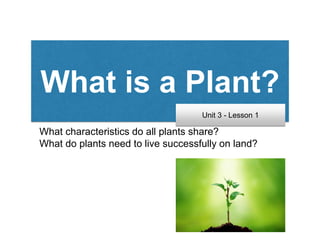
Plants
- 1. What is a Plant? What characteristics do all plants share? What do plants need to live successfully on land? Unit 3 - Lesson 1
- 2. What characteristics do all plants share? • Nearly all plants are autotrophs, organisms that produce their own food. With the exception of one green algae, all plants contain many cells. In addition, all plant cells are surrounded by cell walls.
- 3. What is a Chlorophyll? • Is a green pigment found in the chloroplasts of plants, algae, and some bacteria. (because they are very closely related, plants and green algae both belong to the plant kingdom) • https://www.youtube.com/watch?v=545rqaOJQD8 • https://www.youtube.com/watch?v=aAQYpra4aUs
- 4. • Sunlight provides the energy for a plant’s food- making process, called photosynthesis. • During photosynthesis, a plant uses carbon dioxide gas and water to make food and oxygen.
- 5. Plants vrs. Animals • A difference between plant and animal cells is that plant cells have a cell wall, which surrounds the cell membrane and separates the ell from the environment. • https://www.youtube.com/wa tch?v=9UvlqAVCoqY
- 6. Vacuole • Plants have one large vacuole, or storage sac that can expand and shrink as it fills with water, wastes, and food.
- 7. • With the exception of some green algae, all plants are multicellular, or made up of many cells. • These cells are organized into tissues, or groups of similar cells that perform a specific function in an organism. • https://www.youtube.com/ watch?v=zHp_voyo7MY
- 8. Vascular Tissue • A system of tubelike structures inside a plant, allow minerals, water, and food to move throughout the plant.
- 9. Cuticle • Plants retain water by having a waxy waterproof layer called a cuticle on their leaves and stems.
- 10. What do plants need to live successfully on land? • They must have ways to obtain water and other nutrients from their surroundings, retain water, support their bodies, transport materials, and reproduce. • Plants obtain water and other nutrients from the soil through roots.
- 11. Building Vocabulary • A group of similar cells that perform a specific function is called a ____________. • The internal transporting system through which water, minerals, and food move inside the plant is called ___________________. • A ________________ is a structure inside a plant’s cell in which food is made. • The process by which plants make food is called ________________.
- 12. Building Vocabulary • A ________________ is a waxy, waterproof layer that covers the leaves and stems of most plants. • The sac inside a plant cell where water, wastes, and food are stored is called ______________. • The green pigment called _______________ is necessary to the food-making process in plants.
- 13. Review • Which of the following is thought to be the ancestor of land plants? a. bacteria b. red algae c. ferns d. green algae • Organisms that produce their own food are called? a. heterotrophs b. autosomes c. autotrophs d. herbivores
- 14. Review • The sac inside a plant cell were water, food, and wastes are stored is the ____ a. vacuole b. chloroplast c. chlorophyll d. cuticle • Two structures found in plant cells but NOT in animal cells are a. cell wall and cell membrane b. chloroplasts and cell membrane c. cell wall and chloroplasts d. vacuole and nucleus
- 15. True or False • The cell wall helps a plant retain water. ____ • During photosynthesis, plants produce carbon dioxide. ____ • The green pigment found in specialized plant structures is called chlorophyll. ____ • The system of tubelike structures inside a plant through which water, minerals, and food move is called root tissue. ____
- 16. True or False • Nearly all plants are unicellular. ____ • The energy for photosynthesis comes from the sun. ____
- 17. Classifying Plants What are the characteristics of Nonvascular Plants? What are the characteristics of Seedless Vascular Plants? What are the characteristics of Seed Plants? Unit 3 - Lesson 2
- 18. Plant Structures What are the functions of roots, stems, and leaves? How do seeds become new plants? What are the structures of a flower? Unit 3 – Lesson 3
- 19. ROOTS • Roots anchor a plant in the ground, absorb water and minerals from the soil, and sometimes store food. • Types of roots: Taproot and the Fibrous.
- 21. STEMS • The stem of a plant has two main functions. • The stem carries substances between the plant’s roots and leaves. The stem also provides support for the plant and holds up the leaves so they are exposed to the sun.
- 22. Stem Structure
- 23. LEAVES • Leaves capture the sun’s energy and carry out the food-making process of photosynthesis.
- 25. How does seeds become new plants? Inside a seed is a partially developed plant. If a seed lands in an area where conditions are favorable, the plant sprouts out of the seed and begins to grow.
- 27. Seed Dispersal
- 28. Germination
- 30. Plant Reproduction What are the stages of a plant’s life cycle? How do Plants reproduce? Unit 3 – Lesson 4